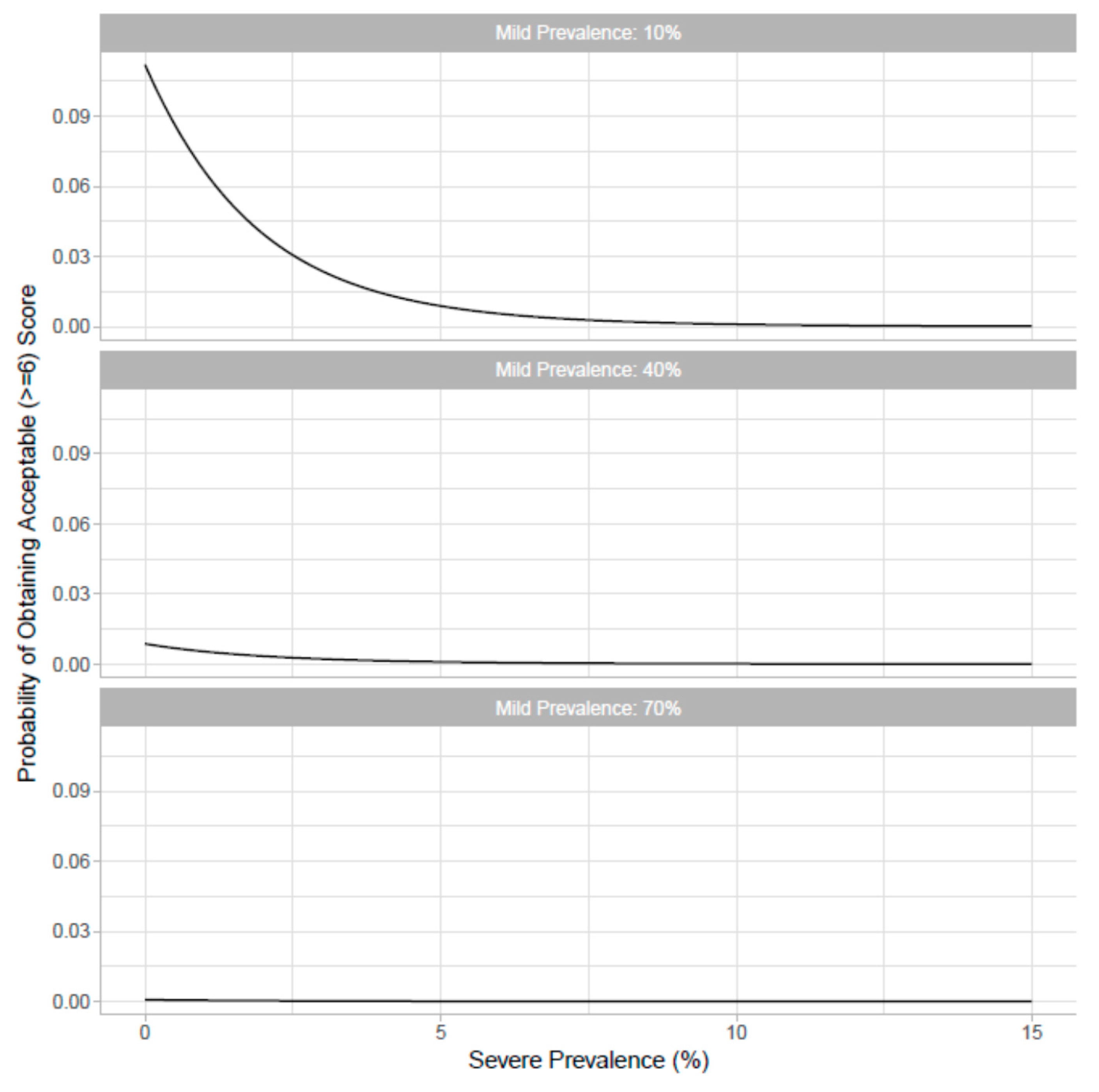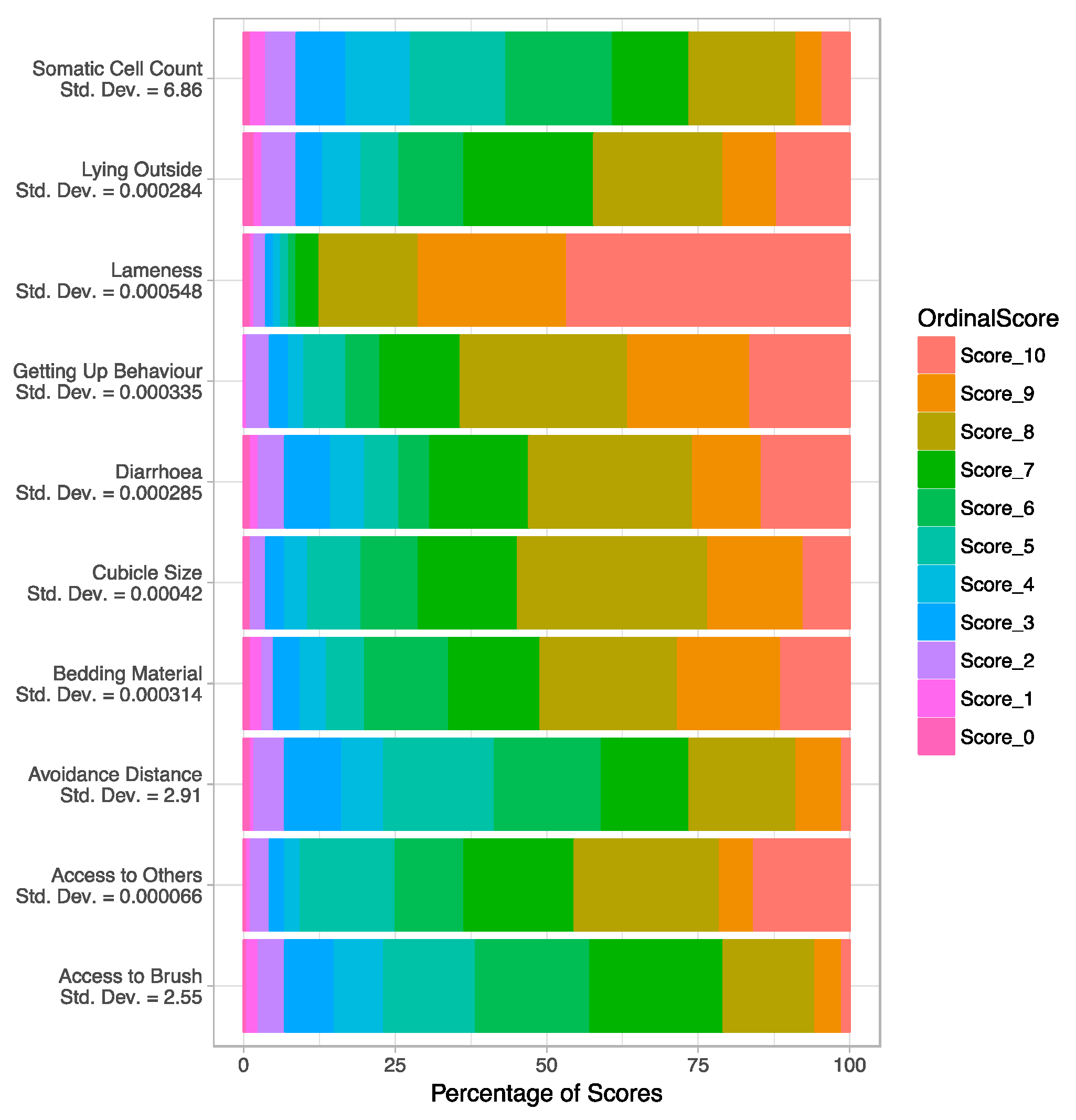Should the Contribution of One Additional Lame Cow Depend on How Many Other Cows on the Farm Are Lame?
Abstract
:Simple Summary
Abstract
1. Introduction
2. Materials and Methods
2.1. Farm Data
2.2. Questionnaire Data
2.2.1. Target Demographic
2.2.2. Expert Rating of the Acceptability of Different Levels of Lameness in Cattle
“The following questions concern various conditions of lameness in herds of dairy cattle. Lameness describes an abnormality of movement and is caused by reduced ability to use one or more limbs in a normal manner. Lameness can vary in severity from reduced ability to inability to bear weight. The term ’lameness in a mild degree’ refers to a reduced ability (imperfect temporal rhythm in stride creating a limp) (see video 1). The term ’severely lame’ refers to a strong reluctance to bear weight on one limb, or to more than one limb being affected (see video 2).”
2.2.3. Expert Rating of the Perceived Validity of Different Welfare Measures Used on Cattle
2.3. Analysis
2.3.1. Questionnaire Data Cleaning
2.3.2. Is Perceived Expert Acceptability of Welfare Problems Non-Linear and Non-Additive?
2.3.3. Will Unacceptable Compensation Be Prevented?
2.3.4. Does the Level of Agreement among Experts Differ Across Measures?
3. Results
3.1. Is Perceived Expert Acceptability of Welfare Problems Non-Linear and Non-Additive?
3.2. Will Unacceptable Compensation Be Prevented?
3.3. Does the Level of Agreement among Experts Differ across Measures?
4. Discussion
5. Conclusions
Supplementary Materials
Acknowledgments
Author Contributions
Conflicts of Interest
References
- Broom, D.M. Animal welfare: Concepts and measurement. J. Anim. Sci. 1991, 69, 4167–4175. [Google Scholar] [CrossRef] [PubMed]
- Veissier, I.; Botreau, R.; Perny, P. Scoring animal welfare: Difficulties and Welfare Quality solutions. In An Overview of the Development of the Welfare Quality Assessment Systems; Keeling, L., Ed.; Cardiff University: Cardiff, UK, 2009; pp. 15–32. [Google Scholar]
- Leach, K.A.; Winckler, C.; Whay, H.R. Lameness in Dairy and Beef Cattle and Veal Calves. In Assessment of Animal Welfare Measures for Dairy Cattle, Beef Bulls and Veal Calves; Forkman, B., Keeling, L., Eds.; Cardiff University: Cardiff, UK, 2009; pp. 35–41. [Google Scholar]
- Botreau, R.; Bracke, M.B.M.; Perny, P.; Butterworth, A.; Capdeville, J.; Van Reenen, C.G.; Veissier, I. Aggregation of measures to produce an overall assessment of animal welfare. Part 2: Analysis of constraints. Animal 2007, 1, 1188–1197. [Google Scholar] [CrossRef] [PubMed]
- De Vries, M.; Bokkers, E.A.M.; van Schaik, G.; Botreau, R.; Engel, B.; Dijkstra, T.; de Boer, I.J.M. Evaluating results of the Welfare Quality multi-criteria evaluation model for classification of dairy cattle welfare at the herd level. J. Dairy Sci. 2013, 96, 6264–6273. [Google Scholar] [CrossRef] [PubMed]
- Knierim, U.; Winckler, C. On-farm welfare assessment in cattle: Validity, reliability and feasibility issues and future perspectives with special regard to the Welfare Quality® approach. Anim. Welf. 2009, 18, 451–458. [Google Scholar] [CrossRef]
- Welfare Quality®. Welfare Quality® Assessment Protocol for Cattle; Welfare Quality® Consortium: Lelystad, The Netherlands, 2009. [Google Scholar]
- Akaike, H. Information theory and an extension of the maximum likelihood principle. In 2nd International Symposium on Information Theory; Petrov, B.N., Csaki, F., Eds.; Akad Kiado: Budapest, Hungary, 1973; pp. 267–281. [Google Scholar]
- Christensen, R.H.B. Regression Models for Ordinal Data. R Package Version 2015.6-28. 2015. Available online: https://cran.r-project.org/web/packages/ordinal/ordinal.pdf (accessed on 28 September 2017).
- R Core Team. R: A Language and Environment for Statistical Computing; R Foundation for Statistical Computing: Vienna, Austria, 2017; Version 3.4.2; Available online: https://www.R-project.org/ (accessed on 28 September 2017).
- Wickham, H. ggplot2: Elegant Graphics for Data Analysis; Springer: New York, NY, USA, 2009. [Google Scholar]
- Lievaart, J.J.; Noordhuizen, J.P.T.M. Ranking experts’ preferences regarding measures and methods of assessment of welfare in dairy herds using Adaptive Conjoint Analysis. J. Dairy Sci. 2011, 94, 3420–3427. [Google Scholar] [CrossRef] [PubMed]
- Whay, H.R.; Main, D.C.J.; Green, L.E.; Webster, A.J.F. Animal-based measures for the assessment of welfare state of dairy cattle, pigs and laying hens: Consensus of expert opinion. Anim. Welf. 2003, 12, 205–217. Available online: http://www.ingentaconnect.com/content/ufaw/aw/2003/00000012/00000002/art00005 (accessed on 28 September 2017).
- De Graaf, S.; Ampe, B.; Winckler, C.; Radeski, M.; Mounier, L.; Kirchner, M.K.; Haskell, M.J.; van Eerdenburg, F.J.C.M.; de Boyer des Roches, A.; Andreasen, S.N.; et al. Trained-user opinion about Welfare Quality measures and integrated scoring of dairy cattle welfare. J. Dairy Sci. 2017, 100, 6376–6388. [Google Scholar] [CrossRef] [PubMed]
- Tuyttens, F.A.M.; Vanhonacker, F.; Van Poucke, E.; Verbeke, W. Quantitative verification of the correspondence between the Welfare Quality® operational definition of farm animal welfare and the opinion of Flemish farmers, citizens and vegetarians. Livest. Sci. 2010, 131, 108–114. [Google Scholar] [CrossRef]



| Model | AIC |
|---|---|
| Simple model (linear effects of mild and severe prevalence with no interaction) | 2404.6 |
| Non-additive model (linear effects of mild and severe prevalence with an interaction) | 2383 |
| Non-linear model (linear and quadratic effects of mild and severe prevalence with no interaction) | 2402.8 |
| Non-additive and non-linear model (linear and quadratic effects of mild and severe prevalence with an interaction between the linear effects) | 2375.8 |
| Lameness Profile | Level 1: Criteria 6 (Absence of Injuries) (Row %) | Level 2: Principle 3 (Good Health) (Row %) | Level 3: Overall (Row %) | |||||||||||
|---|---|---|---|---|---|---|---|---|---|---|---|---|---|---|
| % | (n) | Excellent | Enhanced | Acceptable | Not Classified | Excellent | Enhanced | Acceptable | Not Classified | Excellent | Enhanced | Acceptable | Not Classified | |
| Profile 1: Mild lameness: 5–15%/severe lameness: 0% | 4.5 | (2) | 0 | 100 | 0 | 0 | 0 | 100.0 | 0 | 0 | 0 | 50 | 50 | 0 |
| Profile 2: Mild lameness: 15–40%/severe lameness: 0% | 13.6 | (6) | 0 | 50.0 | 50.0 | 0 | 0 | 50.0 | 50.0 | 0 | 0 | 66.7 | 33.3 | 0 |
| Profile 3: Mild lameness: 40–70%/severe lameness: 0% | 31.8 | (14) | 0 | 7.1 | 92.9 | 0 | 0 | 0 | 100.0 | 0 | 0 | 42.9 | 57.1 | 0 |
| Profile 4: Mild lameness: >70%/severe lameness: 0% | 9.1 | (4) | 0 | 0 | 50.0 | 50.0 | 0 | 0 | 100.0 | 0 | 0 | 25 | 75 | 0 |
| Profile 5: Mild lameness: 15–40%/severe lameness: 5–15% | 4.5 | (2) | 0 | 0 | 100.0 | 0 | 0 | 0 | 100.0 | 0 | 0 | 50 | 50 | 0 |
| Profile 6: Mild lameness: 40–70%/severe lameness: 5–15% | 15.9 | (7) | 0 | 14.3 | 85.7 | 0 | 0 | 14.3 | 85.7 | 0 | 0 | 71.4 | 28.6 | 0 |
| Profile 7: Mild lameness: >70%/severe lameness: 5–15% | 4.5 | (2) | 0 | 0 | 50.0 | 0 | 0 | 0 | 100.0 | 0 | 0 | 50 | 0 | 50 |
| Profile 8: Mild lameness: 15–40%/severe lameness: >15% | 9.1 | (4) | 0 | 0 | 75.0 | 25.0 | 0 | 0 | 100.0 | 0 | 0 | 75 | 25 | 0 |
| Profile 9: Mild lameness: 40–70%/severe lameness: >15% | 6.8 | (3) | 0 | 0 | 66.7 | 33.3 | 0 | 0 | 100.0 | 0 | 0 | 0 | 100 | 0 |
| Total | 100 | (44) | 0 | 15.9 | 72.7 | 11.4 | 0 | 13.6 | 86.4 | 0 | 0 | 50 | 47.7 | 2.3 |
| Prevalence of Lameness | Clearly Unacceptable (Score 0–2) | Partly Unacceptable (Score 3–4) | Partly Acceptable (Score 5–7) | Clearly Acceptable (Score 8–10) |
|---|---|---|---|---|
| Mild lameness: 10%/severe lameness: 0% | 5.1 | 55.2 | 39.2 | 0.4 |
| Mild lameness: 40%/severe lameness: 0% | 43.5 | 52.6 | 4.4 | 0 |
| Mild lameness: 70%/severe lameness: 0% | 90 | 2.7 | 0.1 | 0 |
| Mild lameness: 10%/severe lameness: 5% | 42.9 | 52.1 | 4.3 | 0 |
| Mild lameness: 40%/severe lameness: 5% | 87.3 | 12.2 | 0.5 | 0 |
| Mild lameness: 70%/severe lameness: 5% | 98.1 | 0.7 | 0 | 0 |
| Mild lameness: 10%/severe lameness: 15% | 97.1 | 9.5 | 0.4 | 0 |
| Mild lameness: 40%/severe lameness: 15% | 99.2 | 1.8 | 0.1 | 0 |
| Mild lameness: 70%/severe lameness: 15% | 99.7 | 0.2 | 0 | 0 |
© 2017 by the authors. Licensee MDPI, Basel, Switzerland. This article is an open access article distributed under the terms and conditions of the Creative Commons Attribution (CC BY) license (http://creativecommons.org/licenses/by/4.0/).
Share and Cite
Sandøe, P.; Forkman, B.; Hakansson, F.; Andreasen, S.N.; Nøhr, R.; Denwood, M.; Lund, T.B. Should the Contribution of One Additional Lame Cow Depend on How Many Other Cows on the Farm Are Lame? Animals 2017, 7, 96. https://doi.org/10.3390/ani7120096
Sandøe P, Forkman B, Hakansson F, Andreasen SN, Nøhr R, Denwood M, Lund TB. Should the Contribution of One Additional Lame Cow Depend on How Many Other Cows on the Farm Are Lame? Animals. 2017; 7(12):96. https://doi.org/10.3390/ani7120096
Chicago/Turabian StyleSandøe, Peter, Björn Forkman, Franziska Hakansson, Sine Norlander Andreasen, Rikke Nøhr, Matt Denwood, and Thomas Bøker Lund. 2017. "Should the Contribution of One Additional Lame Cow Depend on How Many Other Cows on the Farm Are Lame?" Animals 7, no. 12: 96. https://doi.org/10.3390/ani7120096
APA StyleSandøe, P., Forkman, B., Hakansson, F., Andreasen, S. N., Nøhr, R., Denwood, M., & Lund, T. B. (2017). Should the Contribution of One Additional Lame Cow Depend on How Many Other Cows on the Farm Are Lame? Animals, 7(12), 96. https://doi.org/10.3390/ani7120096





